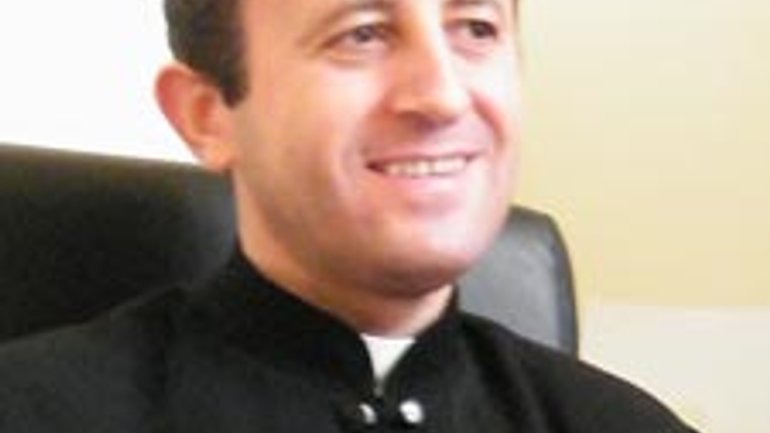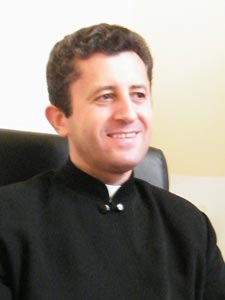Ukrainian Greek Catholic parish in Paris

Interview with the senior priest of the Church of St. Volodymyr of the Ukrainian Greek Catholic Church in Paris with Fr. Mykhailo ROMANIUK about his parish and Ukrainians in France.
 —Father Mykhailo, please tell us about the situation of the Ukrainian Churches in France.
—Father Mykhailo, please tell us about the situation of the Ukrainian Churches in France.
—Our Church of St. Volodymyr the Great in Paris is the cathedra of the Apostolic Exarch of UGCC for the Ukrainians in France, Benelux countries and Switzerland, Bishop Mykhail (Hrynchyshyn). The Exarchate was established on 22 July, 1960 by the beatified Pope John Paul XXIII. In October of this year, we celebrated our 50th anniversary. The exarchate includes ten churches.
As for the Ukrainian Greek Catholic Churches in France, in addition to our Cathedra of St. Volodymyr, we also have a Ukrainian Greek Catholic church in Lion, Lourdes and the town of Vezinchalet, 100 kilometers to the south of Paris. In other cities, our priests celebrate liturgies for the faithful in the French churches once or twice a month or on great holidays. Unfortunately, we have very few priests in France, only six, so we are waiting for vocations from Ukraine.
—Do many parishioners attend the Ukrainian Church in the French city?
—I cannot tell you the exact figure but I can say that each Sunday, 250-300 people come to the service. On big holidays, there are many more of them, over a thousand, so that we even are overcrowded on such days. The people occupy the space around the church, the yard and public garden.
Approximately, 95% of the parishioners are people who came from Ukraine to work in France. There are very few Ukrainians from diaspora, but this may be due to the fact that many of them are elderly and cannot leave their homes. Their children who were born in France have assimilated and maintain no close contacts with the Ukrainian community. Sometimes, they come, of course, but this happens quite seldom. Therefore, I must say that my parishioners are people from Ukraine, so called labour migrants. Some of them have received documents authorizing them to live and work in France but the majority stay in France illegally. Therefore, the community is changing all the time. People come, work for some time and return to Ukraine again. And they are replaced by newcomers who also become our parishioners.
—What does your community live by? Is there any other kind of activity apart from the participation in the services?
—The whole life of the Ukrainian community in Paris rotates around our parish. It has been so since the moment of establishment of our parish in 1943. As you could see at the entrance, this building has a connection to Ukraine even before it became the church. On 25 May, 1926, Symon Petliura died exactly in this building. At that time it was a place of emergency medical aid. From that time, this place has been the first stop of a Ukrainian who comes to Paris. All the events of both the religious and cultural life of Ukrainians in Paris are based on our parish. We celebrate both the Church and national holidays together with the community.
There is a monument to Taras Shevchenko near our Church. I would like to say that it is Shevchenko who brings a lot of people from Ukraine and diaspora to us. All the celebratory events held when officials from Ukraine or the president or a parliament delegation visit are held here.
In addition, a catechetical school and Ukrainian Saturday school, attended by about forty children, is attached to our church. It is quite a lot and there is even no room for all. We have to ask other parishes to be allowed to use a hall where we can conduct lessons.
There is also an icon-painting school attached to the cathedra. It is headed by Hanna Pinkovych, a French woman of the Ukrainian decent. We have a wonderful cathedral choir of St. Volodymyr the Great conducted by Nadia Bilohorodska. We try to cooperate with the faithful in all ways, give them what they lack in a strange country. We organize pilgrimages to Lurd, to St. Teresa of Lize. Therefore, one can confidently say that our Church is a place of prayer and at the same time of gathering and life of the Ukrainian community in Paris.
—You said that you participate in celebration of some national holidays. In what way?
—For instance, on 27 November, the memory of the victims of Holodomor was honoured. We remember them each year, and this year, we also joined the action “Light the candle.” After the vespers, all interested persons had an opportunity to place a candle in the public garden near the monument to Taras Shevchenko.
In addition, for seven or eight years now, we have served a Liturgy in Notre Dame. Our priest from all over the exarchate, that is France, Belgium, Switzerland come to the event. Of course, we also invite French priests and other eastern Catholic priests and they attend. This year, we celebrated it on 21 November, and one of the purposes was to pray for the victims of Holodomor. The liturgies in Notre Dame allow us to inform the world community about this genocide of the Ukrainian nation.
We always join all the actions held in Ukraine. Recently, we laid flowers on the grave of unknown soldier near the Triumph Arch. Each year, on 24 August, on the Independence Day, we and our community come to the monument to Taras Shevchenko and celebrate a thanksgiving liturgy where an Orthodox priest is always present as well.
We also celebrate Shevchenko’s holidays, the Mother’s day, we remember the Chornobyl disaster each year, serve an ecumenical requiem each May on the grave of Symon Petlura and a liturgy in the town of Sanlis, in a monastery built by the wife of the French king, Henry I, Anna Yaroslavna of Kyiv, the Queen of France, etc.
As you could see, we hold an exhibition on Holodomor in our parish hall. The event is in French and we try to tell French people as much as possible about it. In reality, French people know very little about Ukraine, therefore, one can say that our Church is for them a source of information about anything Ukrainian. When a French person visits our church out of interest or need, I always try to speak not only about the church but also about Ukraine.
—How do you manage to handle the economic problems? Is the church a property of the Ukrainian community or do you rent it?
—No, it is not our property. We can use only the first floor of the building. We received the permission for that in 1943 thanks to persistent efforts of Metropolitan Andrey Sheptytskyi. The Metropolitan appointed Fr. Jacob Peridon the Superior of this mission. He was a Dutchman who loved our Church and was ordained a Greek Catholic priest.
The building is associated with an interesting story: when Fr. Piridon saw the house at the cross roads of Riu De san Per and Boulvard Sent Zhermen, he informed Bishop Emmanuil about it. They approached the Rector of the University as the house belonged to the Medical Department. They managed to persuade the university authorities to let the Ukrainian community use the house as its church. Necessary repair works were done at once. The first liturgy was celebrated on Christmas of 1943.
According to the French law, the building was passed to our use for 99 years. In three years’ time, we will celebrate the 70th anniversary of our parish. We do not pay any rent to the city authorities but just pay the bills. Necessary outside repair works or works in the public garden are covered by the French side.
The Church lives exclusively off the donations of our parishioners. Ukrainian people are very sincere and when they see a need to do anything for the beauty of the Church, for the glory of God, they respond very positively. In addition, I would like to say that the parishioners also help churches in the towns and villages whjere their families live in Ukraine. All the repair works and everything we buy is covered by our parishioners. The Church has no other income.









